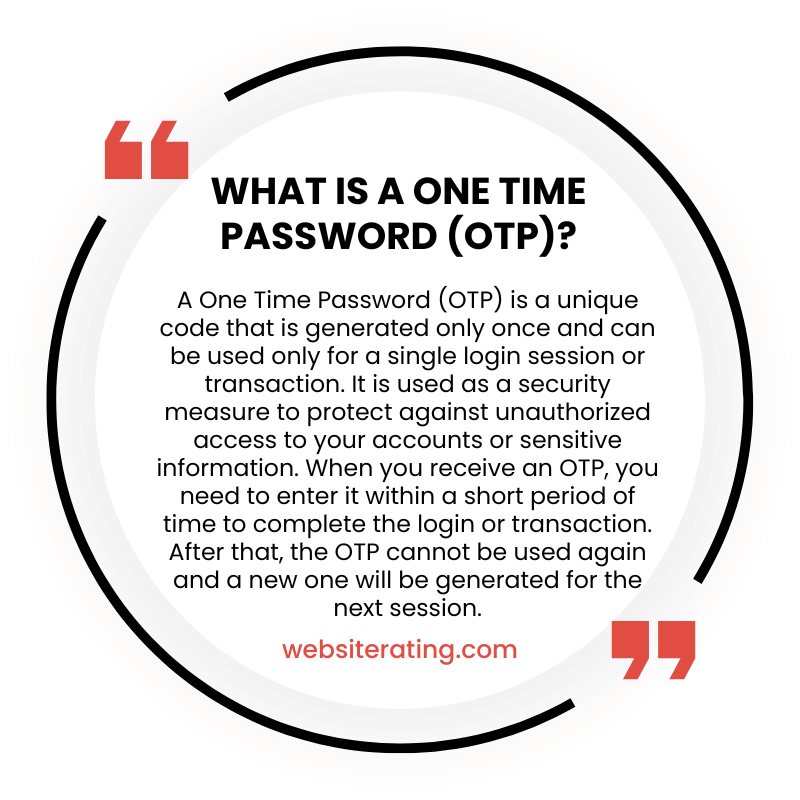A One Time Password (OTP) is a type of authentication method used to verify the identity of a user. It is employed as an additional security measure for ensuring the safety of online accounts and transactions.

OTPs are typically generated through a password manager application, which can be used to generate unique passwords for each account or transaction.
This article will provide an overview of OTPs, including their function, advantages and disadvantages, and practical examples for beginners.
What is an OTP?
An OTP is a form of authentication that requires users to enter a unique code for secure access. This type of password is generated by an application or device and sent to the user via email, text message, or through a mobile app.
The user must then enter this one-time password in order to gain access to their account. OTPs are typically used as an extra layer of security when logging into websites or applications; they can also be used with two-factor authentication systems.
Generally, OTPs are only valid for a single use and become invalid after they have been entered correctly. This makes it difficult for hackers to gain access even if they have stolen the original username and password combination.
Practical examples include using OTPs to verify a credit card transaction online, accessing sensitive information from government websites, or confirming employee attendance at work sites.
How Does an OTP Work?
OTPs are authentication methods that provide a single-use code for verifying a user’s identity. These codes are generated by an algorithm and often sent to the user through a text message or email, and they are only valid for a limited amount of time before becoming invalid.
This helps ensure that the code is not used multiple times, which would compromise security. The process works like this: When a user attempts to login with their credentials, an OTP is sent to them via text message or email.
The user then needs to enter the code in order to gain access to the account. Once entered, the OTP expires after a set period of time and can no longer be used for verification. This type of authentication adds an extra layer of security as it requires the user to possess both their username and password plus have access to their phone or email in order to log into their account.
Advantages and Disadvantages of Using an OTP
The use of an OTP for authentication provides a number of advantages, as well as some drawbacks, which should be taken into consideration when deciding whether or not to incorporate this type of security mechanism.
One benefit of using an OTP is that it prevents attackers from being able to gain access to accounts with stolen passwords since the one-time codes are only valid for a single login session. Additionally, it eliminates the need to remember multiple passwords since users only have to remember one password and their device generates the unique code each time they log in. Furthermore, OTPs do not require any additional hardware or software components; thus, they can potentially reduce costs associated with purchasing additional hardware and software.
However, there are also some disadvantages associated with using an OTP for authentication. For example, if a user loses their device or does not have access to their phone or email account where the code is sent they may not be able to regain access unless they have established backup methods beforehand. Moreover, in certain cases users may find it inconvenient having to wait for a new code each time they want to sign in. Lastly, if someone obtains the code before it is used by its intended recipient then they may be able to gain unauthorized access; however this risk can be mitigated by implementing other security measures such as two-factor authentication (2FA).
Summary
The use of One Time Passwords (OTPs) is becoming increasingly common as an additional layer of security for online accounts. OTPs provide an extra layer of protection from hackers by changing the authentication code each time a user accesses their account. This makes it difficult for someone who has obtained the password to gain access, since the authentication code they have will be invalid once used.
The advantages of using OTPs are clear; however, one must also consider its disadvantages such as difficulty in memorizing and resetting codes if forgotten or lost.
Overall, OTPs offer an effective way to keep personal information safe and secure in the digital age.
More reading
A One Time Password (OTP) is a unique string of characters or numbers that is generated for a single login attempt or transaction. It is used to authenticate a user and is valid only for one session or transaction. OTPs are generated by algorithms that factor in contextual information such as time-based data or previous login events. OTPs are a form of two-factor authentication that provide an additional layer of security beyond traditional static password-based authentication (source: Okta, Wikipedia, Twilio).
